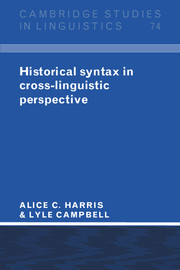Book contents
- Frontmatter
- Contents
- Preface
- List of abbreviations
- 1 Introduction
- 2 The history of historical syntax: major themes
- 3 Overview of a theory of syntactic change
- 4 Reanalysis
- 5 Extension
- 6 Language contact and syntactic borrowing
- 7 Processes that simplify biclausal structures
- 8 Word order
- 9 Alignment
- 10 On the development of complex constructions
- 11 The nature of syntactic change and the issue of causation
- 12 Reconstruction of syntax
- Appendix
- Notes
- References
- Index of languages and language families
- Index of scholars
- Index of subjects
5 - Extension
Published online by Cambridge University Press: 05 June 2012
- Frontmatter
- Contents
- Preface
- List of abbreviations
- 1 Introduction
- 2 The history of historical syntax: major themes
- 3 Overview of a theory of syntactic change
- 4 Reanalysis
- 5 Extension
- 6 Language contact and syntactic borrowing
- 7 Processes that simplify biclausal structures
- 8 Word order
- 9 Alignment
- 10 On the development of complex constructions
- 11 The nature of syntactic change and the issue of causation
- 12 Reconstruction of syntax
- Appendix
- Notes
- References
- Index of languages and language families
- Index of scholars
- Index of subjects
Summary
Introduction
Extension is one of the three basic mechanisms of change in our approach. We defined extension in chapter 3 as change in the surface manifestation of a syntactic pattern that does not involve immediate or intrinsic modification of underlying structure. Many aspects of extension are discussed in chapter 4, especially in section 4.4. This chapter is devoted to a more detailed description and presentation of examples. The central purpose of the chapter is to state a constraint on extension.
It has often been said that diachronic change simplifies the grammar; yet it has often been pointed out that if that were always so, grammars would become noticeably simpler in the course of time. In the realm of syntax, it is clear that reanalysis often can introduce complexity to the grammar (though it can also result in simplification, as well), while extension can eliminate exceptions and irregularities by bringing the new analysis into line with the rest of the existing grammar. The constraint on extensions, formulated below as (39), makes concrete the observation that extension always plays this role.
Extension is a mechanism that operates to change the syntax of a language by generalizing a rule, and in section 5.2 we give two examples of this. The constraint which we discuss in greater detail in section 5.3 below states minimum observed limits on the application of extension in general. There are still stronger constraints, which seem to operate on individual aspects of grammar, and these are discussed in chapters 7–9.
- Type
- Chapter
- Information
- Historical Syntax in Cross-Linguistic Perspective , pp. 97 - 119Publisher: Cambridge University PressPrint publication year: 1995

